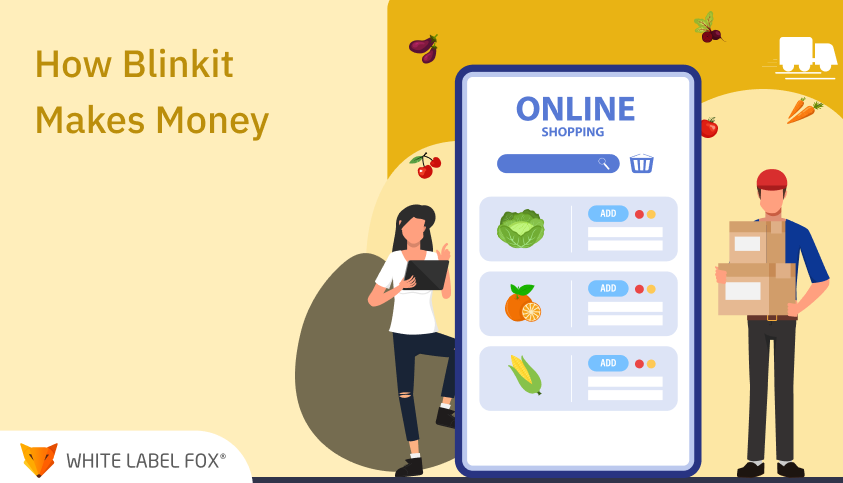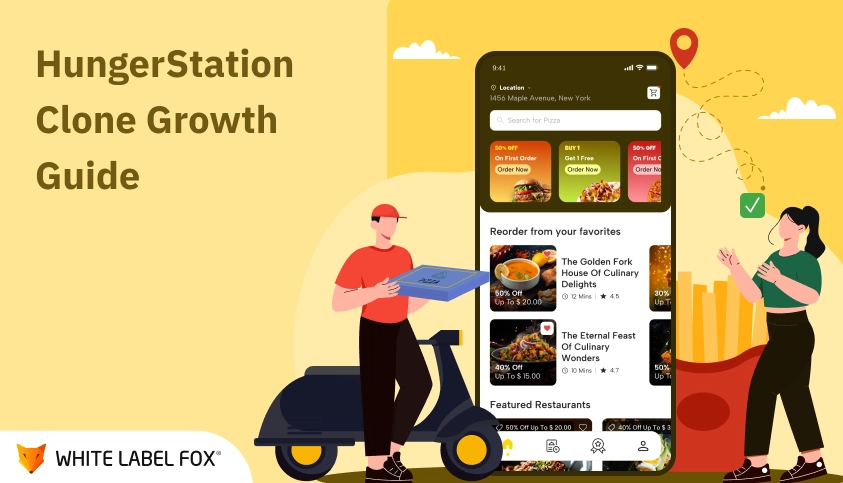Demand for online meal ordering and delivery has increased steadily in recent years. This sector saw steady growth when people struck at their homes and were forced to follow social distancing rules. Online food delivery giants like Just Eat made it possible for restaurants to keep their businesses running and meet customers’ changing needs. If you’re thinking of developing a platform similar to a delivery giant, having insight into the Just Eat business model can help you know how delivery works and make money.
Online food ordering & delivery fad among consumers all around the globe as they prefer comfort & want everything to be delivered to their place. In 2022 the global food delivery sector is estimated to reach around 130.2 billion U.S. dollars; this number is projected to increase by 223.7 billion U.S. dollars by the end of 2027. The market was forecasted to increase at 11% CAGR over the period considered.
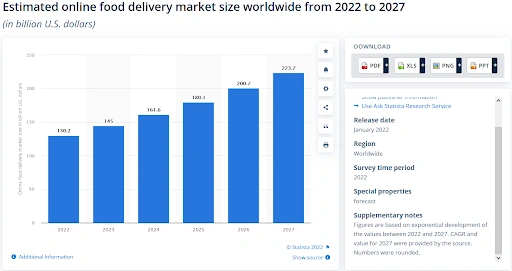
The food ordering and delivery businesses have a bright future as more customers these days prefer to have sizzling meals delivered to their doorsteps whenever they want to enjoy them. If you are seeking an opportunity to become a part of a growing industry, White Label Fox can help you with that. An impressive ready-to-use Just Eat clone can help you launch a successful venture online and manage activities efficiently.
What is Just Eat?
Just Eat is an online meal delivery marketplace that connects customers with restaurants. The food ordering and delivery platform provides its service in more than 24 countries. Also, it has collaborated with around 580,000 local restaurants. Just Eat Takeaway operates focusing on the local market. It enables customers to search for restaurants and order food through the website, iOS app, or Google app.
JustEat Foundation, Funding History, & Success Story to Have Insight into!
Operated by Netherlands-based Just Eat Takeaway.com, JustEat is an online meal ordering and delivery brand. In 2001, it was launched as a separate company in Kolding, Denmark, and headquartered in the U.K. The company acts as an intermediary between takeaway food outlets and customers.
Are You Planning To Develop A Food Delivery App Like Just Eat?
Learn More About Our Readymade Clone Script.
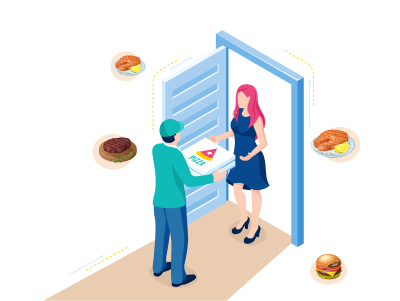
Just Eat provides its service in more than seven counties and enables consumers to search for local restaurants, place orders, and make payments online. It also enables customers to choose between pick-up and delivery options. Have a quick look over the success time to know the complete details of the food ordering and delivery company right below.
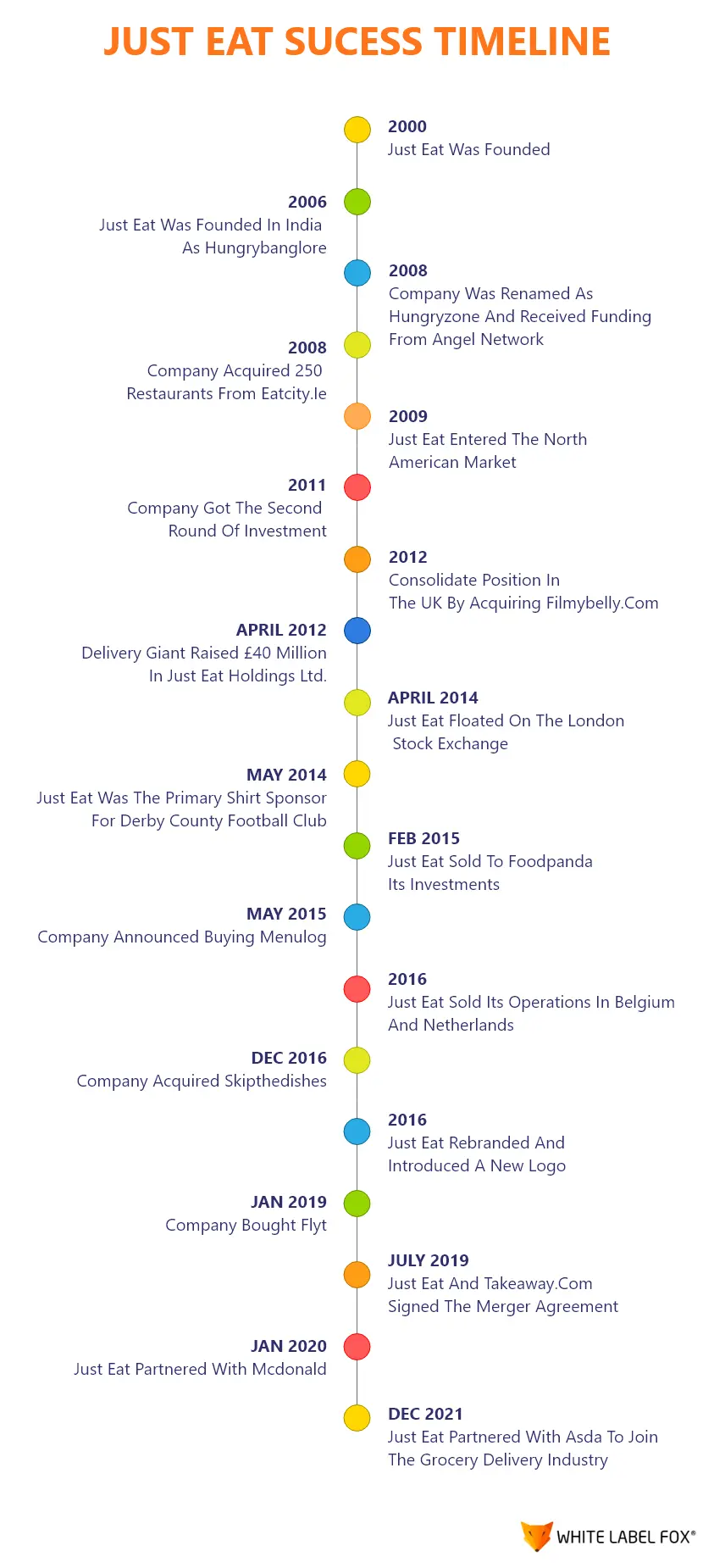
Just Eat takeaway doorbell giveaway caters to ticketless Champion League fans. It was created in support of Just Eat Takeaways’ sponsorship of the Uefa Champions League; the stunt was captured for posterity by Liverpool and YouTuber fan Callum Airey.
https://twitter.com/darkhorsesldn/status/1530633100102885381
The Takeaway food market globally is expected to witness massive growth by 2029; delivery giants, including JustEat, will have significant revenue and sales. Moreover, Just Eat Takeaways value a great portion; more than 33% is made by a stake in iFood.
The value can be realized by JET management since Prosus owns 66% of iFood. Just Eat Takeaway.com N.V.’s enterprise value is for a great portion made up of a 33% stake in iFood, showcasing how undervalued the sum of the parts basis. The company has 28.2 billion euros in total gross value.
Getting inspired by the success of Just Eat, many are choosing to develop advanced solutions similar to it. They are trying to understand how Just Eat works by understanding the Just Eat takeaway business model. If you’re looking to automate your restaurant or food ordering and delivery business operations, have a quick look over the flow and understand how our branded solution helps you manage business activities from one place: https://whitelabelfox.com/food-ordering-app-live-demo/.
Just Eat Business Model: How Delivery Company Caters to Customers’ Growing Needs?
Just Eat operates on a hybrid business model, meaning the company partners with restaurants to cater to the growing food delivery needs of customers. They work together by entering into independent contracts to cater to the orders. Success-based Just Eat business model ensures great cash flow and creates value for restaurants, shareholders, and other partners.
The impressive Just Eat Takeaway business model helped the company to complete millions of orders effectively. In 2020, the company received nearly 588 million orders; this number shows a great increase as measured around 413 million during previous years.
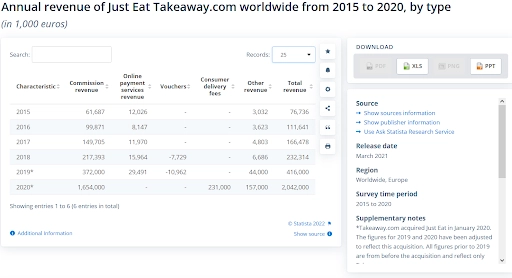
Just Eat Takeaway.com operates under distinct brand names in different countries. For example, Thuisbezorgd.nl in the Netherlands or Lieferando.de in Germany. More than 60 million active customers actively registered with Just Eat Takeaway in 2020; the majority of customers were from the United Kingdom and Germany.
There are two interdependent customer segments in the marketplace-based Just Eat business model; these include:
Customers: Those who want to order food from local restaurants.
Restaurants: Local food stores and restaurants that want a large customer base and offer take-out.
As an intermediate between restaurants and customers, Just Eat easily manages product sorting, discovery, orders, payment process, and everything related to delivery. Customers can explore menu items through the website and the company’s app. Let’s explore the customer segment and more to understand the Just Eat business model and identify how it operates to satisfy the needs of food lovers.
Value Proposition For Customers
The company provides three key value propositions to customers that are performance, customization, and convenience. Feature-rich online food ordering and the delivery app provide convenience to customers by enabling them to identify all the restaurants nearby.
Customers who love the take-out option can download the Just Eat app on their smart device or can visit the website to make an order. They can use multiple payment options to complete hassle-free payments. Also, write reviews about the restaurant and delivery provider with ease.
Value Proposition For Restaurants
Just Eat provides mainly four value propositions to restaurants and other food stores: accessibility, performance, decreased risk, and convenience. The delivery company improves the accessibility of restaurants by informing customers about them. This enables restaurants to get more customers and improve their business reach.
Just Eat helps restaurants generate more orders. The easy-to-use delivery platform generates more than 2,500 orders during peak hours. Additionally, restaurant online orders are almost 25% more than telephonic orders.
Customer Segmentation
Just Eat follows a multi-faceted business model with two primary independent segments that are essential to operating a successful business.
Customers:
- Individuals who want to order Takeaway from a local restaurant;
- Food lovers who want to enjoy tasty and delicious meals;
- People with busy schedules who don’t have enough time to cook.
Restaurant:
- Food stores that want to improve their business reach;
- Grocery stores that want to expand their customer base;
- Those who are expect to grow their business sales and profits.
Recently Just Eat has reveal a list of six of Bradford’s best-reviewed takeaways. The food delivery brand focuses on developing great relationships with its customers. They are allowed to use the service through the leading platform and with limited interactions with employees. Besides, it also enables restaurants to answer all customers’ doubts through phone, email, etc.
Just Eat Revenue Model: How Delivery Company Makes Money?
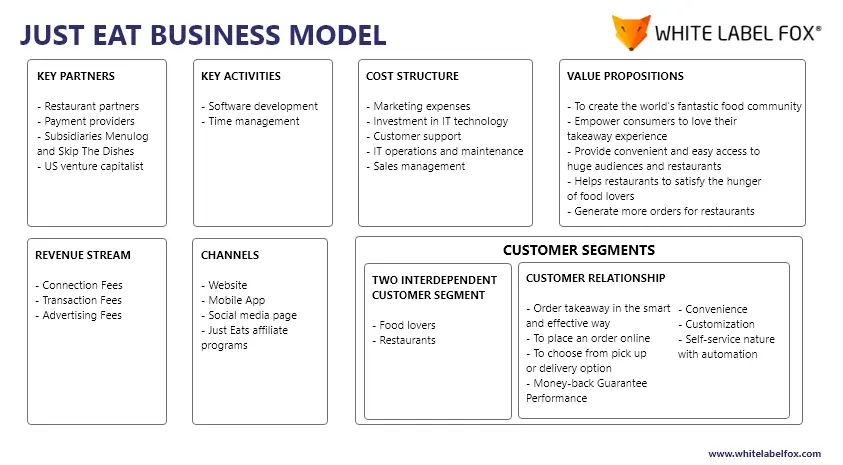
Effective Just Eat Takeaway business model makes it easier for an online platform to provide the best food ordering and delivery service. The company operates under various brand names in many countries, including Thuisbezorgd.nl in the Netherlands and Lieferando.de in Germany.
Just Eat Takeaway grew between 2015 and 2020; in 2015, the revenue amounted to around 77 million euros, whereas it increased by two billion euros in 2020. The Dutch portal Thuisbezorgd.nl saw a total value that was higher than their competitors Deliveroo and Hungry.
Just Eat’s revenue increased by 33%, which is around €5.3B in 2021; it has raised a combined $2.9 billion across nine rounds of debt funding and equity. Leading investors include Index Ventures, Rheingau Founders, Prime Ventures, Redpoint, Venrex, and 83North.
You might be wondering about how Just Eat makes money through its revenue model; it earns through delivery fees, restaurant fees, and more. Let’s explore the Just Eat revenue model in-depth right here.
Restaurant Commissions
Most of Just Eat Takeaways’ revenue comes from restaurants as the platform charges a commission for every order. Restaurant commissions differ depending on many factors, including restaurant location and others as well. Just Eat charges 10 to 15% of commission from restaurants.
Delivery and Services Fees
Just Eat also charges delivery fees and service fees from customers. The app costs between zero to £4.50 per delivery; this charge depends on distance. Just Eat charges around £1.99 or more as an additional cost.
Sponsored Placements Within The Platform
Just Eat partners can boost their presence through promoted placements. It is an advertising platform that places a restaurant in the top five results on its website and app. The delivery giant also charges through the Cost Per Click (CPC) model, which means each time customers click on advertising, the restaurant has to pay a small commission.
Interchange Fees
Just Eat Takeaway partnered with Adyen in 2021, a payment processor that provides online payments for various tech businesses. They introduced the Takeaway Pay Card, which is a pre-funded debit card that workers can use for meal expenses. The card permits all the employees to buy goods and services at thousands of eateries & shops that accept Mastercard and Maestro.
Get Your Food Delivery Platform Developed Today!
We hope this article might help you to have insight into the Just Eat business model, how it makes money and more. Looking to the Just Eat success, if you are thinking of starting a similar business, White Label Fox can help you with it. Check the online delivery service app pricing and more to make a smart choice: https://whitelabelfox.com/online-delivery-service-app-price/.
Our developers can deploy feature-rich food ordering and delivery apps as per your business requirements. Just specify your requirements, and we will do the rest. Contact us today to know how we can help you streamline your business process: [email protected].
Frequently Ask Questions
Just Eat is an online food delivery service that connects customers with
local restaurants, allowing them to place food orders through the Just
Eat website or app. Customers can browse through a wide variety of
restaurants, choose their preferred meals, and place an order for home
delivery. Just Eat then facilitates the transaction by either delivering
the food themselves or outsourcing it to the restaurant for delivery.
Just Eat offers several key features that enhance its customer and
restaurant experience:
- Restaurant Selection: Customers can choose from a wide
range of
local restaurants offering various types of cuisines.
- Order Tracking: Just Eat provides real-time tracking,
allowing
customers to know exactly when their order will arrive.
- Payment Integration: Customers can pay for their orders
through
credit cards, debit cards, or digital wallets directly on the
app or
website.
- Customer Ratings and Reviews: Customers can rate and
review
restaurants based on their experience, which helps others make
informed decisions.
- Subscription Plans: For regular customers, Just Eat
offers
loyalty
and subscription programs like “Just Eat Plus,” which provides
discounts, delivery fee waivers, and exclusive deals.
- Restaurant Selection: Customers can choose from a wide range of local restaurants offering various types of cuisines.
- Order Tracking: Just Eat provides real-time tracking, allowing customers to know exactly when their order will arrive.
- Payment Integration: Customers can pay for their orders through credit cards, debit cards, or digital wallets directly on the app or website.
- Customer Ratings and Reviews: Customers can rate and review restaurants based on their experience, which helps others make informed decisions.
- Subscription Plans: For regular customers, Just Eat offers loyalty and subscription programs like “Just Eat Plus,” which provides discounts, delivery fee waivers, and exclusive deals.
Just Eat serves multiple customer segments:
- End Consumers: Individuals looking for convenient food
delivery from
their favorite restaurants or exploring new dining options.
- Restaurants: Local and national restaurants that want to
expand
their customer base by listing their menus on the Just Eat
platform.
- Delivery Drivers: Independent contractors or delivery
drivers
who
work with Just Eat to deliver food to customers.
- Advertisers: Food brands and restaurants that use Just
Eat’s
platform for advertising their products to a wide audience.
- End Consumers: Individuals looking for convenient food delivery from their favorite restaurants or exploring new dining options.
- Restaurants: Local and national restaurants that want to expand their customer base by listing their menus on the Just Eat platform.
- Delivery Drivers: Independent contractors or delivery drivers who work with Just Eat to deliver food to customers.
- Advertisers: Food brands and restaurants that use Just Eat’s platform for advertising their products to a wide audience.
For restaurants, Just Eat provides an easy way to offer delivery
services without needing their own delivery infrastructure. Restaurants
partner with Just Eat by listing their menus on the platform, and when
customers place an order, Just Eat facilitates the transaction and
delivery (or the restaurant delivers the food itself). Restaurants are
charged a commission on each order, with additional fees for premium
listings and promotional features. Just Eat helps restaurants reach a
larger audience, streamline their operations, and boost sales.
Just Eat uses a combination of customer feedback, data analytics, and
operational management to maintain service quality:
- Customer Reviews and Ratings: Customers can rate their
food and
delivery experience, which helps Just Eat monitor the quality of
service and restaurant performance.
- Restaurant Audits: Just Eat performs periodic quality
checks and
audits to ensure that the restaurants listed on their platform
meet
certain standards for food safety and delivery times.
- Real-Time Tracking: The platform allows for real-time
order
tracking, helping ensure that orders are delivered on time and
in
good condition.
- Customer Support: Just Eat has dedicated customer service
teams
to
resolve any issues or complaints quickly and efficiently,
maintaining customer satisfaction.
- Customer Reviews and Ratings: Customers can rate their food and delivery experience, which helps Just Eat monitor the quality of service and restaurant performance.
- Restaurant Audits: Just Eat performs periodic quality checks and audits to ensure that the restaurants listed on their platform meet certain standards for food safety and delivery times.
- Real-Time Tracking: The platform allows for real-time order tracking, helping ensure that orders are delivered on time and in good condition.
- Customer Support: Just Eat has dedicated customer service teams to resolve any issues or complaints quickly and efficiently, maintaining customer satisfaction.
Customers typically incur the following costs when using Just Eat:
- Delivery Fee: Just Eat charges a delivery fee, which
varies
depending on location and order size.
- Service Charge: Just Eat may add a service charge on
certain
orders,
which is a small percentage of the total order cost.
- Food Costs: The actual price of the food ordered depends
on the
restaurant’s menu.
- Optional Tips: While tips are optional, customers can
choose to
tip
delivery drivers or restaurant staff for exceptional service.
- Delivery Fee: Just Eat charges a delivery fee, which varies depending on location and order size.
- Service Charge: Just Eat may add a service charge on certain orders, which is a small percentage of the total order cost.
- Food Costs: The actual price of the food ordered depends on the restaurant’s menu.
- Optional Tips: While tips are optional, customers can choose to tip delivery drivers or restaurant staff for exceptional service.
Just Eat differentiates itself in the market in several ways:
- Broad Restaurant Partnerships: Just Eat partners with a
wide
variety
of restaurants, from local eateries to large national chains,
giving
customers plenty of choices.
- Global Reach: Unlike many competitors, Just Eat operates
in
multiple
countries, offering international and localized delivery
services.
- Flexible Delivery Options: Just Eat offers both
restaurant-managed
and company-managed deliveries, depending on the location and
the
partnership with the restaurant.
- Easy-to-Use App: Just Eat’s mobile app and website are
user-friendly, making it easy for customers to order food and
track
their deliveries.
- Broad Restaurant Partnerships: Just Eat partners with a wide variety of restaurants, from local eateries to large national chains, giving customers plenty of choices.
- Global Reach: Unlike many competitors, Just Eat operates in multiple countries, offering international and localized delivery services.
- Flexible Delivery Options: Just Eat offers both restaurant-managed and company-managed deliveries, depending on the location and the partnership with the restaurant.
- Easy-to-Use App: Just Eat’s mobile app and website are user-friendly, making it easy for customers to order food and track their deliveries.
Just Eat enjoys several competitive advantages in the food delivery
market:
- Established Brand: As one of the largest and most
recognizable
food
delivery services globally, Just Eat has significant brand
equity
and a loyal customer base.
- Wide Market Reach: Just Eat has a presence in multiple
countries,
allowing it to serve a broad audience.
- Partnership with Top Restaurants: Just Eat has secured
partnerships
with many leading restaurant chains, expanding its offerings and
attracting more customers.
- Technology and Innovation: The platform continually
innovates
with
features like AI-driven recommendations, dynamic pricing, and
improved logistics to optimize the customer experience.
- Established Brand: As one of the largest and most recognizable food delivery services globally, Just Eat has significant brand equity and a loyal customer base.
- Wide Market Reach: Just Eat has a presence in multiple countries, allowing it to serve a broad audience.
- Partnership with Top Restaurants: Just Eat has secured partnerships with many leading restaurant chains, expanding its offerings and attracting more customers.
- Technology and Innovation: The platform continually innovates with features like AI-driven recommendations, dynamic pricing, and improved logistics to optimize the customer experience.
Despite its success, Just Eat faces several challenges:
- Competition: Just Eat faces stiff competition from other
food
delivery giants like Deliveroo, Uber Eats, and Grubhub, all of
which
are vying for market share.
- Delivery Costs: Delivery is one of the most expensive
aspects of
Just Eat’s business, and rising fuel and labor costs can impact
profitability.
- Customer Retention: While Just Eat offers an easy-to-use
platform,
retaining customers amidst fierce competition requires
continuous
innovation and value-added services.
- Restaurant Satisfaction: Restaurants may face pressure
from the
commission fees and the competition from other platforms, which
can
affect Just Eat's relationships with restaurant partners.
- Competition: Just Eat faces stiff competition from other food delivery giants like Deliveroo, Uber Eats, and Grubhub, all of which are vying for market share.
- Delivery Costs: Delivery is one of the most expensive aspects of Just Eat’s business, and rising fuel and labor costs can impact profitability.
- Customer Retention: While Just Eat offers an easy-to-use platform, retaining customers amidst fierce competition requires continuous innovation and value-added services.
- Restaurant Satisfaction: Restaurants may face pressure from the commission fees and the competition from other platforms, which can affect Just Eat's relationships with restaurant partners.




